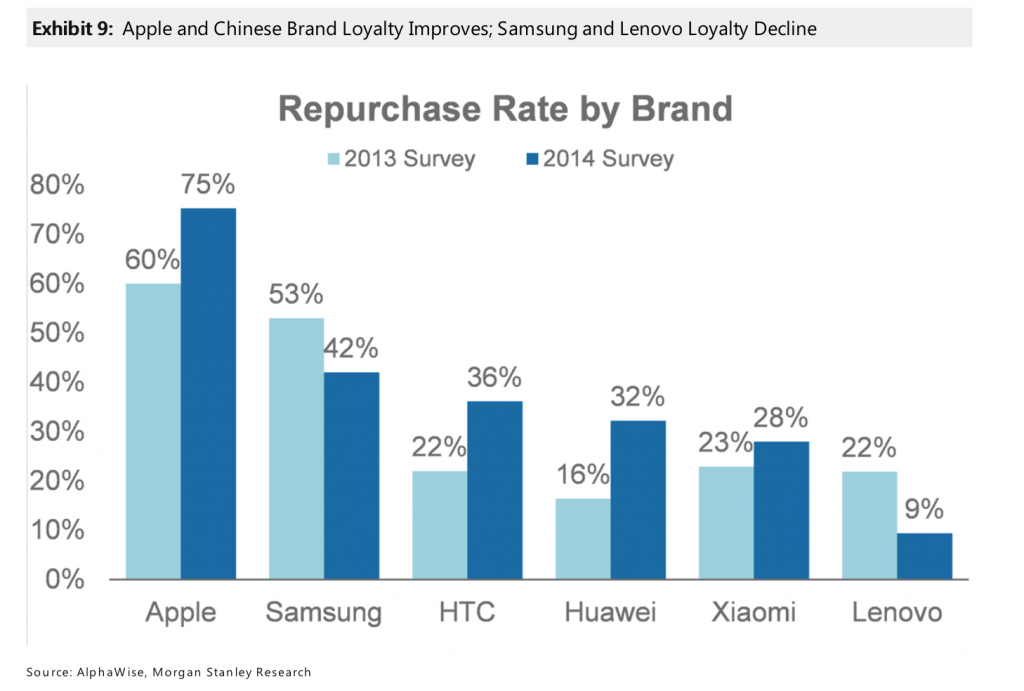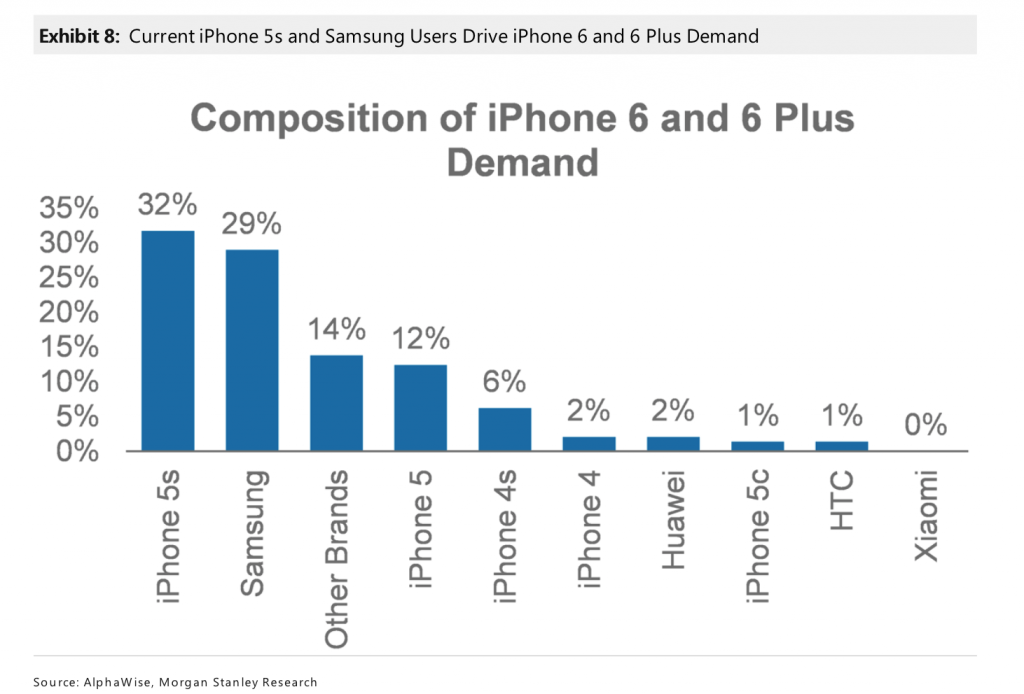I’ve been asked this question often and feel there is a great deal of misunderstanding regarding the dynamics and strategies of the two companies. I was quick to point out during Xiaomi’s rise that they pose more of a threat to Samsung and this has proven to be true. Samsung’s issues are a combined double whammy from both Apple on the premium end and Xiaomi in the mid-to-low end. Xiaomi is on my radar first and foremost because they are building a brand. My belief is a good brand is one of the hardest things to build globally but also one of the most sustainable efforts a company can engage in, especially in the worldwide consumer market. Xiaomi is a threat for this reason. But to believe Xiaomi disrupts or threatens Apple is an incorrect assumption. Let’s look at a few data points to highlight this.
In a report from Morgan Stanley where their analysts model the iPhone 6 and 6 Plus upside, several charts from their survey data are insightful. First there is this one:

This chart highlights repurchase intent by brand. Notice which companies decreased in “brand repurchase intent” — Samsung and Lenovo. This chart is telling of consumer sentiment more than anything else. Apple and Xiaomi remain “sticky”, while the rise of HTC and Huawei show many global consumers willing to look at new options in the Android hardware landscape.
Another chart from the survey is insightful of the dynamic between Apple and Xiaomi.

Owners of the specific devices and brands that were interested in the new iPhones were plotted. Xiaomi was included due to the lack of intent to switch from the Xiaomi brand to the new iPhones. This is a notable data point, but it is one that does not tell the whole story.
A report in the Financial Times last week had a very specific sentence that highlights an incredibly important distinction between how Chinese consumers view Apple and Xiaomi respectively.
As one Beijing-based entrepreneur puts it, “the tech grad who has worked at Baidu as an engineer for two years, that’s their target gatekeeper and prestige consumer. In China’s tier two and three cities, that is someone people look up to. People want to see what kind of phone such a guy is using.”
Creating an aspirational brand at the low end of the income scale is an accomplishment, and it is difficult to replicate. Xiaomi’s products are seen as a cross between a commodity and a luxury item, although one techie notes that while many of his peers use its phones “eventually they end up making more money and buy Apple”.
Several key takeaways from this statement back up a lot of the feedback we hear from China. Xiaomi is doing as good a job as any of creating a premium brand for the low-to-mid range of the smartphone market. Young Chinese consumers who are upwardly mobile are choosing Xiaomi as their starting point. This has an effect on the aspirational middle class at the early stages of their mobility. They are not the phone for the poor but also not the phone for the rich. The previous quote makes this clear. Xiaomi is an aspirational brand for those on their way up. Apple is their ultimate aspirational brand once they have “made it”.
External appearances and what that says about your status is central in China. A Xiaomi phone says, “I’m not at the bottom. I’m on my way up”. An iPhone says “I’ve made it.” This is a powerful and important distinction to understand at a psychological level about Chinese consumers.
Xiaomi is the Gateway for Apple
The more I study these dynamics, the more I am convinced Xiaomi is paving the way in China for Apple. I say this for a few reasons. The first is because what Xiaomi has copied from Apple is more than just hardware and software UI. They have actually copied their ecosystem. MiCloud is, in concept, just like iCloud. Store images, documents, and more in the cloud and access them from any browser. They have their own app store, messenger, TV box and interface, and more. Many of the things about Xiaomi’s ecosystem beyond hardware and software are similar to Apple’s. They are providing the Apple ecosystem but with a lower cost of entry.
At first I believed this would be a challenge to Apple but then realized it is good for Apple. Xiaomi is grooming customers to understand the value of an ecosystem with multiple touch points. Customers are getting content across a number of different screens and seeing the convenience of the multi-screen era. This is new in China and nonexistent in other emerging markets for now. Xiaomi is giving low end and mid-tier consumers a small taste of the Apple ecosystem but without the significant lock in.
Obviously, for many who can’t afford to move up or get Apple hardware, the Xiaomi ecosystem will suffice. But in China specifically, the transition of Xiaomi customers to the Apple ecosystem will increasingly become attractive due to the Chinese consumer psychology. Many Xiaomi customers may start in their ecosystem but many will also not stay there.
This “moving up” mentality of consumers is exactly what Apple hopes, I believe. Their strategy is to play at the premium tier and hope that, as emerging market consumers mature from their first device and begin to refine their needs, wants, and desires with technology, over time they will consider Apple’s full solution.
In China, I believe Xiaomi is unknowingly paving the way for their customers and leading more and more of them to Apple’s door. Those who believe Apple should be worried about Xiaomi miss the point that Xiaomi should be worried about Apple, at least in China. This is a story line I will maintain throughout 2015.

I think Xiaomi is currently providing the ideal combination of cost & functionality for the a great many of the 95% of the world’s population which will never be able to afford an Apple product. I do wonder how they are doing this profitably. If 7 billion people will have smartphones by 2020 as projected it will be done by purchases at the lowest end of the market upward to the mid range.
Xiaomi has seized the opportunity and blind-sided Samsung and is stealing a lot of its market share while Apple is stealing Samsung’s profits. Apple will probably get all that can in the next quarter while the door is wide open for Xiaomi.
I agree with you on the game they are playing. They are bringing an ecosystem like approach, like Apple’s at mainstream prices. They are one of the few companies I think are interesting and doing sustainable things.
Apple is not the one stealing here. What goes around can come back to bite you…..
Great article. I’m also interested in how Xiaomi will move out of China with IP issues. I hear they use google services outside of China. How are they making money in that scenario? How “local” are their services…are they ready to expand outside of China and into other cultures? Inquiring minds want to know 🙂
Yes, this is the question of the ages for them. How they make money is going to be a challenge since it is clear it is most in hardware. And it does seem they are committed to Google’s services outside of China.
Watching Xiaomi to see how they go about this will be fascinating. Interesting upside but real and significant challenges exist for them.
very satisfying in terms of information thank you very much.